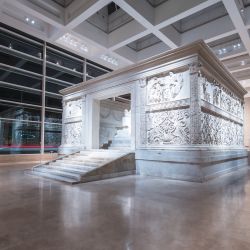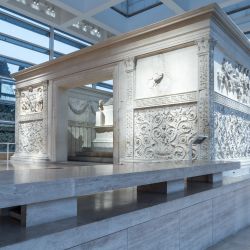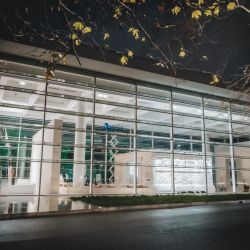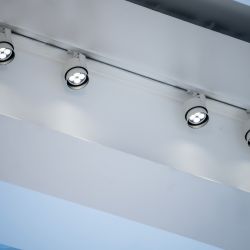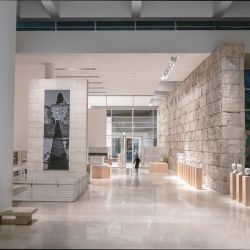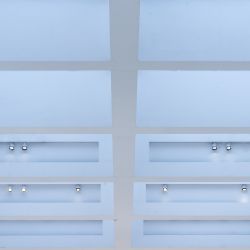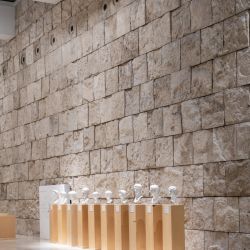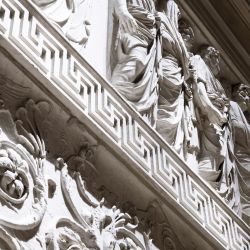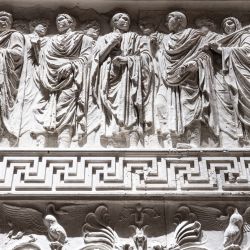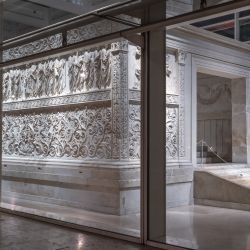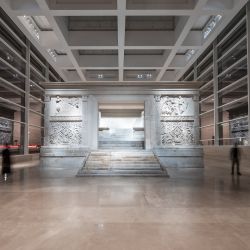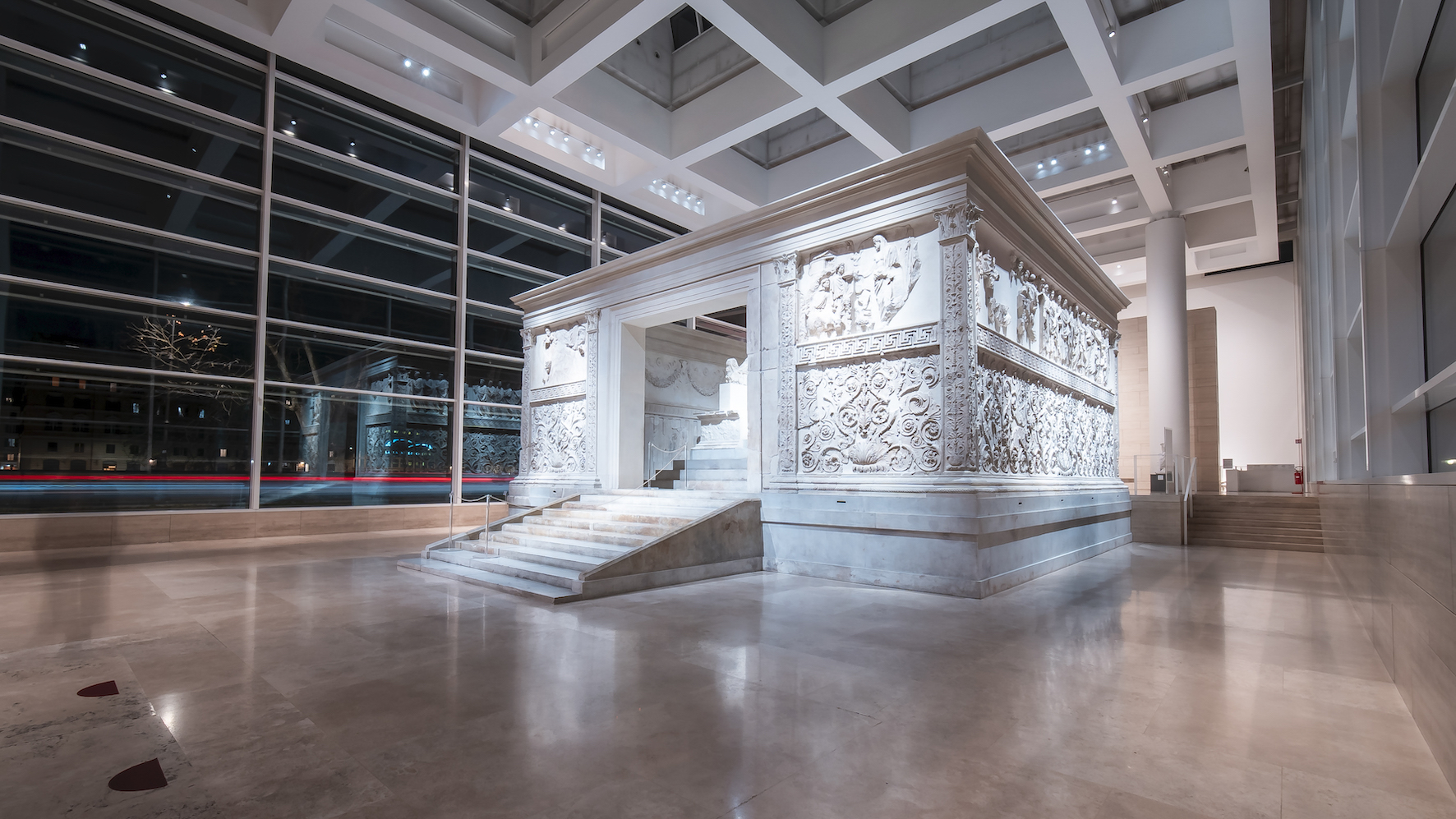
Download this article:
The Altar of Augustan Peace is one of the most important ancient monuments in Rome. In 2006, Richard Meier & Partners created the glass building of the Museo dell' Ara Pacis, which protectively surrounds the altar. The original lighting concept for the building has now been converted to energy-efficient, low-maintenance LED spotlights and wallwashers, supplied by ERCO. This new and highly sustainable lighting system convinces in terms of quality of perception and economy – as well as scoring with energy savings of around 85%.
In honour of Emperor Augustus, who had victoriously returned to Rome, the Roman Senate commissioned a magnificent marble altar in 13 BC. The provinces had been pacified following decades of civil war and the Pax Augusta promised stability and prosperity. The deeds of the celebrated ruler and his family, vividly and three-dimensionally depicted on the enclosing walls of the Ara Pacis Augustae, were intended to become a model for the citizens of the empire. Since 2006, the Altar of Augustan Peace, one of Rome's most important ancient monuments, is housed and can be admired in the Museo dell'Ara Pacis in the vicinity of banks of the Tiber. The airy building designed by Richard Meier & Partners includes areas for temporary exhibitions in addition to the large glazed hall with the altar.
A total of 218 LED lighting tools from ERCO now illuminate the museum and its central exhibit of the ancient altar in new light. The aim of the conversion from halogen lighting to contemporary LED illumination was, in addition to improved energy efficiency, to increase the quality of visual perception of the monument and the associated spatial experience. The original lighting concept, based on the idea of 'positive contrast', was retained: it not only uses nuanced levels of brightness to create perceptual hierarchies between the exhibit and surrounding space, but also builds up additional contrast through the use of different colour temperatures. General lighting with a warm white light colour defines the space around the Altar of Augustan Peace. Carved entirely of Carrara marble, the monument itself is set clearly apart from its surroundings thanks to the powerful directional lighting with a neutral white light colour.
An impressive spatial and artistic experience due to nuanced lighting
The tour through the museum leads from the entrance hall through a corridor into the main exhibition hall with a height of about 12.50 metres. A row of Lightcast recessed luminaires (32W LED/3000K) provides the general lighting for the axis of movement. Parscan spotlights (24W LED/3000K) with flood distribution (28°) and Parscan wallwashers (24W LED/3000K) make the special dimensions of the room perceptible through uniform vertical illumination of the walls, whilst simultaneously emphasising their quarrystone surfaces of fine Roman travertine. Parscan spotlights with narrow spot distribution (6°) and an 8W LED module set precise beams of light on a row of ancient busts marking the transition into the main hall.
85% energy savings: relighting with maintenance-free ERCO LED luminaires
In the exhibition hall with the altar, Parscan spotlights (24W LED) with a warm white light colour of 3000K and spot distribution (16°) provide general lighting. The sacrificial altar itself, enclosed by four walls, is illuminated by Parscan spotlights (8W LED) with neutral white light colour of 4000K and narrow spot distribution (6°). This directional accent light creates an expressive interplay of light and shadow on the ornate marble reliefs and enables the depicted figures to be emphasised in a sculptural way. A specific challenge for the lighting design in the central hall around the Altar of Augustan Peace was the changing daylight that enters through skylights and through the two fully glazed sides of the building. With the help of sensors and Casambi Bluetooth control, the new lighting now responds accordingly: light intensity is regulated in such a way that the marble reliefs on the exterior surfaces of the altar are optimally illuminated, with the monument standing out against its surroundings in a radiant white. In addition, further pre-defined light scenes can be called up depending on the season, time of day and use of the museum.
All Parscan spotlights with LED were mounted on existing ERCO track, which kept installation effort and costs low. The new lighting system with ERCO LED lighting tools, commissioned by the City of Rome and generously sponsored by Bulgari, represents a sustainable investment. Maintenance-free and with a long service life, its connected load is only 8.4 kW compared to the 57 kW of the old system, which means it consumes around 85% less energy.
Link to the reportage
Link to the film
Project data
Client: Roma Capitale / Italy
Architecture: Richard Meier & Partners Architects, New York / USA
Light planning: Fisher Marantz Stone, New York / USA
Photography: Marcela Schneider Ferreira, Florence / Italy
Products: Parscan, Lightcast, Opton
Photo credits: © ERCO GmbH, www.erco.com, photography: Marcela Schneider Ferreira
About ERCO
The ERCO Light Factory in the German town of Lüdenscheid is a leading international specialist in architectural lighting using LED technology. The family business, founded in 1934, now operates as a global player with independent sales organisations and partners in 55 countries worldwide. Since 2015, ERCO’s portfolio has been 100% LED. With this in mind, ERCO in Lüdenscheid develops, designs and produces digital luminaires with focus on photometrics, electronics and design. Working closely with architects, lighting designers and engineers, ERCO develops lighting tools used primarily for applications in the following fields: Work and Culture, Community and Public/Outdoor, Contemplation, Living, Shop and Hospitality. ERCO understands digital light as the fourth dimension of architecture – providing highly precise and efficient lighting solutions to support creative designers in turning their visions into reality.
If you require any further information on ERCO or image material, please visit us at press.erco.com/en. We can also provide you with material on projects worldwide for your media coverage.
Relevant image material
© ERCO GmbH, www.erco.com, photography: Marcela Schneider Ferreira
© ERCO GmbH, www.erco.com, photography: Marcela Schneider Ferreira
© ERCO GmbH, www.erco.com, photography: Marcela Schneider Ferreira
© ERCO GmbH, www.erco.com, photography: Marcela Schneider Ferreira
© ERCO GmbH, www.erco.com, photography: Marcela Schneider Ferreira
© ERCO GmbH, www.erco.com, photography: Marcela Schneider Ferreira
© ERCO GmbH, www.erco.com, photography: Marcela Schneider Ferreira
© ERCO GmbH, www.erco.com, photography: Marcela Schneider Ferreira
© ERCO GmbH, www.erco.com, photography: Marcela Schneider Ferreira
© ERCO GmbH, www.erco.com, photography: Marcela Schneider Ferreira
© ERCO GmbH, www.erco.com, photography: Marcela Schneider Ferreira
© ERCO GmbH, www.erco.com, photography: Marcela Schneider Ferreira
© ERCO GmbH, www.erco.com, photography: Marcela Schneider Ferreira
© ERCO GmbH, www.erco.com, photography: Marcela Schneider Ferreira
